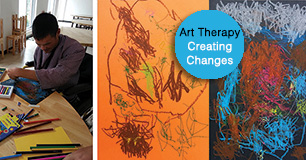
Like many other Chinese people who are born outside of China, I feel attached to China. Loving different aspects of the Chinese culture is deeply rooted in me, there is also an enigma drawing me towards this vest giant where my ancestors were from. I remember reading books on the history of China and Chinese immigrants, which touched a core deep in my heart.
When the 2008 Sichuan earthquake happened, the intense emotions I once experienced as a child back in 1979 Tangshan earthquake resurfaced. I had a strong urge to go and help in Sichuan but it was not possible for me to leave Singapore then. It was wonderful to know that some fellow art therapists from the Art Therapists’ Association Singapore were able to go with another organisation and helped.
Time has passed us by since the devastating earthquake and I had not realised the mighty power of disaster, which had left colossal damages which still require lots of continuous support and maintenance for decades to come. Last year when Singapore Red Cross and Red Pencil reached out to provide psychosocial support to the Sichuan earthquake survivors and volunteers, I decided I would go on behind of the Association to help.
Only when I arrived Sichuan did I realised the magnitude of the damage caused by the earthquake; and the vast difficulties survivors and helping organisations have had to face. I went with a small team from SRC to a make shift care centre in a remote village. With the help of a student art therapist, a medical student and a student nurse, we provided therapeutic art activities to children with disabilities (Figure 1 & 2) and the team of staff at the site (Figure 3) who have been volunteers at the site since 2008. We provided groups of activities daily during our short stay and soon participants were eagerly engaging in the sessions, even though it was their first experience trying out therapeutic art activities. The therapeutic art activities allowed them to express difficult emotions from deep within. The sessions allowed them to connect emotionally as a group, a family, survivors and co-workers. Many, including the children with disabilities, were able to verbalise their needs and wishes to their peers and the therapist (Figure 4).
The power of the art process strengthened the bond between us. The disabled children residents felt that they belonged; even though they rarely see their real families if there were any. After soldiering on all these years since the earthquake, the workers felt their spirit was fortified by togetherness despite the encountering of many difficulties. My team felt empowered just by facilitating the sessions and by being there. I felt patriotic towards China and being a Chinese (Figure 5), knowing that I can contribute to make a difference in Sichuan.
By Yesmin Chan







